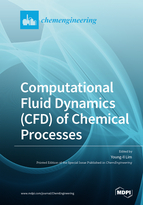Computational Fluid Dynamics (CFD) of Chemical Processes
A special issue of ChemEngineering (ISSN 2305-7084).
Deadline for manuscript submissions: closed (31 July 2020) | Viewed by 22235
Special Issue Editor
Interests: process systems engineering; sustainable process engineering; process simulation; multiscale simulation; computational fluid dynamics; machine learning; deep learning; energy-efficient process development
Special Issue Information
Dear Colleagues,
The rise in computational capacity has allowed improved modeling and simulation capabilities for chemical processes. Computational fluid dynamics (CFD) is a useful tool to study the performance of a process following geometrical and operational modifications. CFD is suitable for identifying hydrodynamics inside processes with complex geometries where chemical reactions and heat and mass transfers occur. CFD has received much attention from researchers in recent years, increasing the number of publications in 2018 by two times compared to 2011 (ScienceDirect, 2019).
In this Special Issue of ChemEngineering, we would appreciate your contribution in the CFD field. This Special Issue is mainly focused on multiphase, multiphysics, and multiscale CFD simulations applied to chemical and biological processes. However, novel and nontraditional CFD approaches are also welcome.
Prof. Young-Il Lim
Guest Editor
Manuscript Submission Information
Manuscripts should be submitted online at www.mdpi.com by registering and logging in to this website. Once you are registered, click here to go to the submission form. Manuscripts can be submitted until the deadline. All submissions that pass pre-check are peer-reviewed. Accepted papers will be published continuously in the journal (as soon as accepted) and will be listed together on the special issue website. Research articles, review articles as well as short communications are invited. For planned papers, a title and short abstract (about 100 words) can be sent to the Editorial Office for announcement on this website.
Submitted manuscripts should not have been published previously, nor be under consideration for publication elsewhere (except conference proceedings papers). All manuscripts are thoroughly refereed through a single-blind peer-review process. A guide for authors and other relevant information for submission of manuscripts is available on the Instructions for Authors page. ChemEngineering is an international peer-reviewed open access semimonthly journal published by MDPI.
Please visit the Instructions for Authors page before submitting a manuscript. The Article Processing Charge (APC) for publication in this open access journal is 1600 CHF (Swiss Francs). Submitted papers should be well formatted and use good English. Authors may use MDPI's English editing service prior to publication or during author revisions.
Keywords
- Gas phase CFD of chemical processes such as gas distributors and incinerators
- Liquid phase CFD of chemical processes such as CSTR with mixer
- Gas–solid CFD of chemical processes such as cyclones and fluidized beds
- Gas–liquid CFD of chemical processes such as bubble columns and absorbers
- Gas–liquid–solid CFD of chemical processes such as slurry bubble columns
- Multiscale CFD simulation
- Eulerian or Lagrangian CFD models and applications
- CFD simulation with Multiphysics
- Nontraditional CFD approaches






